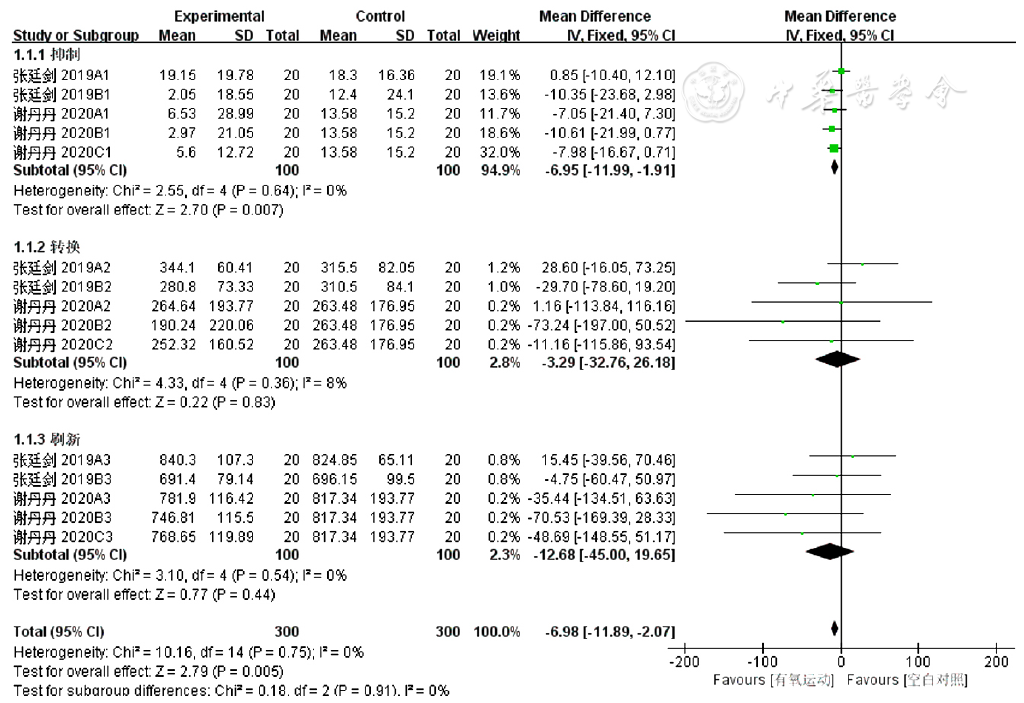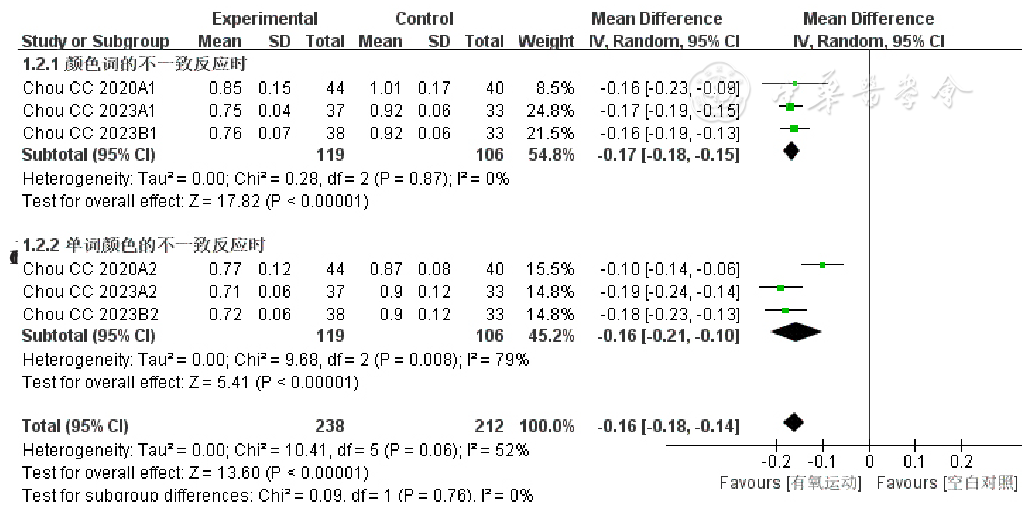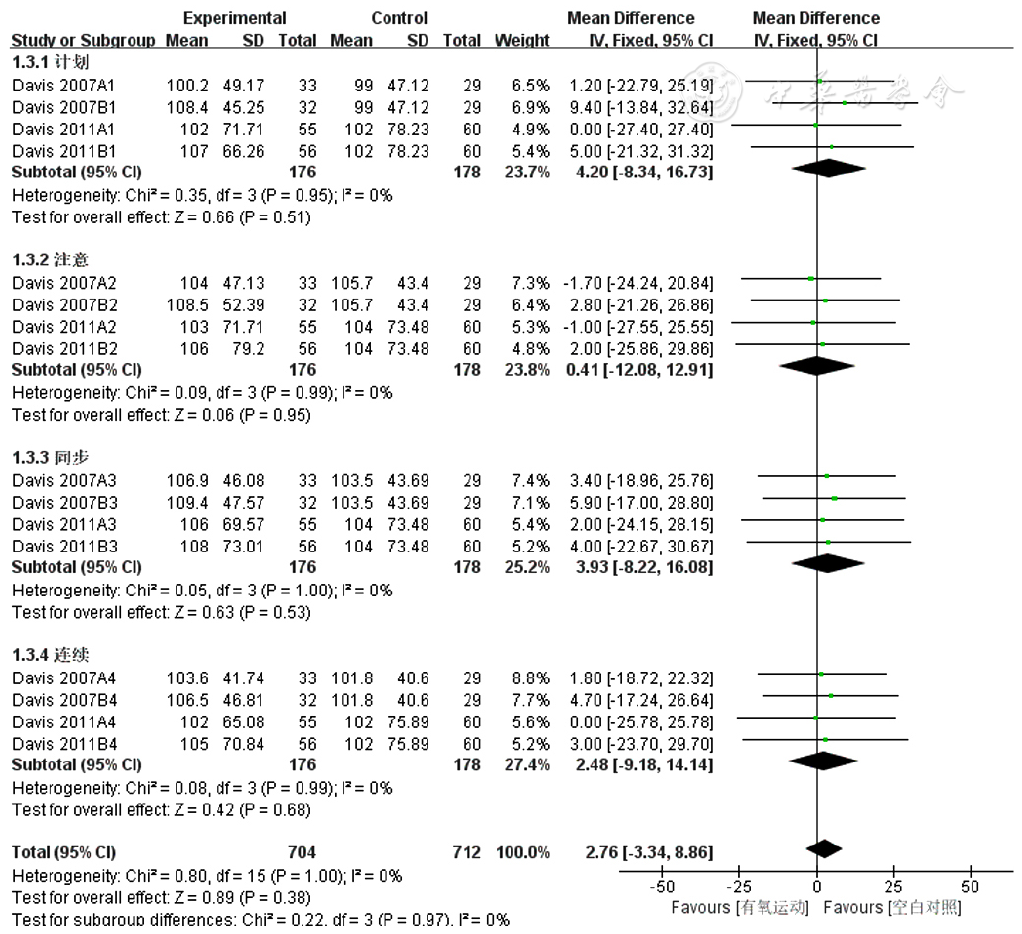中国全科医学 ›› 2024, Vol. 27 ›› Issue (30): 3817-3824.DOI: 10.12114/j.issn.1007-9572.2023.0810
所属专题: 儿科最新文章合辑; 运动相关研究最新文章合辑; 肥胖最新文章合辑
收稿日期:2023-12-10
修回日期:2024-01-28
出版日期:2024-10-20
发布日期:2024-07-09
通讯作者:
陈乐琴
作者贡献:
赵瑞负责论文的选题、设计及撰写者,对文章整体负责;陈乐琴负责论文评估、思路的指导;吴依妮负责资料搜集、数据的整理者;李倩倩负责表格的整理。
基金资助:
ZHAO Rui1, CHEN Leqin1,*( ), WU Yini1, LI Qianqian2
), WU Yini1, LI Qianqian2
Received:2023-12-10
Revised:2024-01-28
Published:2024-10-20
Online:2024-07-09
Contact:
CHEN Leqin
摘要: 背景 研究证实,超重肥胖儿童执行功能与肥胖密切相关,并可能存在双向关联。有氧运动作为一种有效的干预手段,可有效促进其大脑发展和认知功能,尤其是执行功能,但改善效果的量化关系仍需要进一步探讨。 目的 系统评价有氧运动对超重肥胖儿童执行功能相关指标干预效果。 方法 检索中国知网(CNKI)、万方数据知识服务平台(Wanfang Data)、中国生物医学文献数据库(CBM)、Cochrane Library、PubMed、Embase、Web of Science数据库中有氧运动干预超重肥胖儿童执行功能的随机对照试验,检索时限从各数据库建库至2023年7月。依据Cochrane风险偏倚评估工具对纳入的文献进行质量评估,采用RevMan 5.4和Stata 15.0软件对结局指标进行Meta分析。 结果 最终纳入9项随机对照试验,其中包括940例超重肥胖儿童。Meta分析结果显示,单次有氧运动干预能够有效提高超重肥胖儿童的执行功能(WMD=-6.98,95%CI=-11.89~-2.07,P=0.005);亚组分析结果显示,单次干预时长<30 min的有氧运动对超重肥胖儿童执行功能子成分的改善均无显著性差异(WMD=-0.84,95%CI=-9.37~7.68,P=0.85);单次干预时长>30 min的有氧运动可改善超重肥胖儿童的抑制功能(WMD=-10.50,95%CI=-19.15~-1.85,P=0.02)。进行长期运动干预(干预周期为8周)时,与对照组相比,有氧运动可改善超重肥胖儿童干扰控制(WMD=-0.16,95%CI=-0.18~-0.14,P<0.000 01),对计划(WMD=4.20,95%CI=-8.34~16.73,P=0.51)、注意(WMD=0.41,95%CI=-12.08~12.91,P=0.95)、同步(WMD=3.93,95%CI=-8.22~16.08,P=0.53)、连续(WMD=2.48,95%CI=-9.18~14.14,P=0.68)的改善效果不明显。 结论 单次长时间的有氧运动对超重肥胖儿童执行功能子成分有选择性积极影响,长周期固定频次、时间的有氧运动可以改善超重肥胖儿童干扰控制能力,但计划、注意、同步、连续方面未产生改善效果。
| 检索步骤 | 检索式 |
|---|---|
| #1 | aerobic exercise[Mesh] |
| #2 | aerobic training[Title/Abstract] OR Physical Activity[Title/Abstract] OR Physical Exercise[Title/Abstract] OR Acute Exercise[Title/Abstract] OR Exercise,Isometric[Title/Abstract] OR endurance exercise[Title/Abstract] OR Treadmill[Title/Abstract] OR walking[Title/Abstract] OR Jogging[Title/Abstract] OR Swimming[Title/Abstract] OR Dancing[Title/Abstract] OR Cycling[Title/Abstract] OR Taijiquan[Title/Abstract] |
| #3 | #1 OR #2 |
| #4 | Obesity[Mesh] |
| #5 | Overweight[Mesh] |
| #6 | Obese[Title/Abstract] OR Body mass index[Title/Abstract] OR body fat[Title/Abstract] OR excess weight[Title/Abstract] |
| #7 | #4 OR #5 OR #6 |
| #8 | Child[Title/Abstract] |
| #9 | Executive Function[Mesh] |
| #10 | Executive Control[Title/Abstract] OR Cognitive Function[Title/Abstract] OR cognitive performance[Title/Abstract] OR inhibitory control[Title/Abstract] OR Shifting[Title/Abstract] OR working memory[Title/Abstract] OR Planning[Title/Abstract] OR cognitive function[Title/Abstract] OR Refresh function[Title/Abstract] OR cognitive flexibility[Title/Abstract] OR Reasoning[Title/Abstract] OR problem solving[Title/Abstract] |
| #11 | #9 OR #10 |
| #12 | randomized controlled trial[Publication Type] OR randomized[Title/Abstract] OR placebo[Title/Abstract] |
| #13 | #3 AND #7 AND #8 AND #11 AND #12 |
表1 PubMed数据库文献检索策略
Table 1 Search strategy for PubMed database
| 检索步骤 | 检索式 |
|---|---|
| #1 | aerobic exercise[Mesh] |
| #2 | aerobic training[Title/Abstract] OR Physical Activity[Title/Abstract] OR Physical Exercise[Title/Abstract] OR Acute Exercise[Title/Abstract] OR Exercise,Isometric[Title/Abstract] OR endurance exercise[Title/Abstract] OR Treadmill[Title/Abstract] OR walking[Title/Abstract] OR Jogging[Title/Abstract] OR Swimming[Title/Abstract] OR Dancing[Title/Abstract] OR Cycling[Title/Abstract] OR Taijiquan[Title/Abstract] |
| #3 | #1 OR #2 |
| #4 | Obesity[Mesh] |
| #5 | Overweight[Mesh] |
| #6 | Obese[Title/Abstract] OR Body mass index[Title/Abstract] OR body fat[Title/Abstract] OR excess weight[Title/Abstract] |
| #7 | #4 OR #5 OR #6 |
| #8 | Child[Title/Abstract] |
| #9 | Executive Function[Mesh] |
| #10 | Executive Control[Title/Abstract] OR Cognitive Function[Title/Abstract] OR cognitive performance[Title/Abstract] OR inhibitory control[Title/Abstract] OR Shifting[Title/Abstract] OR working memory[Title/Abstract] OR Planning[Title/Abstract] OR cognitive function[Title/Abstract] OR Refresh function[Title/Abstract] OR cognitive flexibility[Title/Abstract] OR Reasoning[Title/Abstract] OR problem solving[Title/Abstract] |
| #11 | #9 OR #10 |
| #12 | randomized controlled trial[Publication Type] OR randomized[Title/Abstract] OR placebo[Title/Abstract] |
| #13 | #3 AND #7 AND #8 AND #11 AND #12 |
| 第一作者 | 发表年份(年) | 样本量(T/C) | 年龄(岁) (T/C) | 试验组 | 结局指标 | |
|---|---|---|---|---|---|---|
| 干预方案 | 周期、频率、时长 | |||||
| KRAFFT[ | 2014 | 43(24/19) | T:9.7±0.8 C:9.9±0.9 | 有氧运动(捉人、跳绳):HR>150次/min | 8个月,5 d/周,40 min/次 | ① |
| 谢丹丹[ | 2020 | 80(60/20) | T#:9.65±0.67 T##:9.75±0.64 T###:9.75±0.64 C:9.90±0.72 | 篮球+"8"字跳绳:5 min热身与拉伸→10 min(HR 130~150次/min)→2 min休息→10 min(HR 130~150次/min)→2 min休息 | 一次性运动:20 min/次、30 min/次、40 min/次 | ①②③ |
| 张廷剑[ | 2019 | 80(40/40) | T#:10.20±0.69 T##:10.40±0.50 C#:10.30±0.73 C###:10.50±0.51 | 篮球+"8"字跳绳:热身与拉伸→基本部分(HR 130~150次/min)→总结与放松 | 一次性运动:20 min/次、40 min/次 | ①②③ |
| CHOU[ | 2020 | 84(44/40) | T:12.30±0.66 C:12.08±0.69 | 运动游戏:10 min热身→30 min运动游戏(HR>150次/min) | 8周,3 d/周,40 min/次 | ④ |
| CHOU[ | 2023 | 108(37、38/33) | T#:11.37±0.58 T###:11.00±0.64 C:11.32±0.54 | 竞争性团队游戏(跑步、跳绳、改良足球、棒球、篮球):10 min热身→20 min/40 min(60%~69%)HRmax→10 min放松 | 8周,5 d/周,20 min/次或40 min/次 | ④ |
| CHEN[ | 2016 | 50(25/25) | T:12.64±0.70 C:12.84±0.75 | 5 min热身→30 min中等强度(60%~70%)HRmax→5 min放松 | 3个月,4 d/周,40 min/次 | ⑤ |
| DAVIS[ | 2007 | 94(33、32/29) | 9.20±0.84 | 5 min热身→20 min/40 min(HR>150次/min)→5 min热身 | 15周,5 d/周,20 min/次或40 min/次 | ⑥ |
| DAVIS[ | 2011 | 171(55、56/60) | 9.3±1.0 | 5 min热身→20 min/40 min(HR>150次/min)→5 min热身 | 13周,5 d/周,20 min/次或40 min/次 | ⑥ |
| GALLOTTA[ | 2015 | 230(78、83/69) | 8~11 | 协调训练:15 min热身→30 min(5<RPE<8身体活动)→15 min热身 | 60 min/次,5个月 | ⑦ |
表2 纳入研究的基本特征
Table 2 Basic characteristics of the included studies
| 第一作者 | 发表年份(年) | 样本量(T/C) | 年龄(岁) (T/C) | 试验组 | 结局指标 | |
|---|---|---|---|---|---|---|
| 干预方案 | 周期、频率、时长 | |||||
| KRAFFT[ | 2014 | 43(24/19) | T:9.7±0.8 C:9.9±0.9 | 有氧运动(捉人、跳绳):HR>150次/min | 8个月,5 d/周,40 min/次 | ① |
| 谢丹丹[ | 2020 | 80(60/20) | T#:9.65±0.67 T##:9.75±0.64 T###:9.75±0.64 C:9.90±0.72 | 篮球+"8"字跳绳:5 min热身与拉伸→10 min(HR 130~150次/min)→2 min休息→10 min(HR 130~150次/min)→2 min休息 | 一次性运动:20 min/次、30 min/次、40 min/次 | ①②③ |
| 张廷剑[ | 2019 | 80(40/40) | T#:10.20±0.69 T##:10.40±0.50 C#:10.30±0.73 C###:10.50±0.51 | 篮球+"8"字跳绳:热身与拉伸→基本部分(HR 130~150次/min)→总结与放松 | 一次性运动:20 min/次、40 min/次 | ①②③ |
| CHOU[ | 2020 | 84(44/40) | T:12.30±0.66 C:12.08±0.69 | 运动游戏:10 min热身→30 min运动游戏(HR>150次/min) | 8周,3 d/周,40 min/次 | ④ |
| CHOU[ | 2023 | 108(37、38/33) | T#:11.37±0.58 T###:11.00±0.64 C:11.32±0.54 | 竞争性团队游戏(跑步、跳绳、改良足球、棒球、篮球):10 min热身→20 min/40 min(60%~69%)HRmax→10 min放松 | 8周,5 d/周,20 min/次或40 min/次 | ④ |
| CHEN[ | 2016 | 50(25/25) | T:12.64±0.70 C:12.84±0.75 | 5 min热身→30 min中等强度(60%~70%)HRmax→5 min放松 | 3个月,4 d/周,40 min/次 | ⑤ |
| DAVIS[ | 2007 | 94(33、32/29) | 9.20±0.84 | 5 min热身→20 min/40 min(HR>150次/min)→5 min热身 | 15周,5 d/周,20 min/次或40 min/次 | ⑥ |
| DAVIS[ | 2011 | 171(55、56/60) | 9.3±1.0 | 5 min热身→20 min/40 min(HR>150次/min)→5 min热身 | 13周,5 d/周,20 min/次或40 min/次 | ⑥ |
| GALLOTTA[ | 2015 | 230(78、83/69) | 8~11 | 协调训练:15 min热身→30 min(5<RPE<8身体活动)→15 min热身 | 60 min/次,5个月 | ⑦ |

图4 有氧运动对超重肥胖儿童执行功能影响的森林图注:A为20 min试验组,B为40 min试验组,C为30 min试验组。
Figure 4 Forest plot of the effects of aerobic exercise on executive function in overweight and obese
| 亚组分析 | 异质性检验结果 | 效应模型 | Meta分析结果 | |||
|---|---|---|---|---|---|---|
| I2值 | P值 | WMD(95%CI) | P值 | |||
| 单次运动干预时长<30 min | ||||||
| 执行功能 | 抑制 | 0 | 0.40 | 固定 | -2.16(-11.01~6.69) | 0.63 |
| 转换 | 0 | 0.66 | 固定 | 25.00(-16.62~66.63) | 0.24 | |
| 刷新 | 0 | 0.38 | 固定 | 133.69(85.60~181.78) | 0.89 | |
| 单次运动干预时长>30 min | ||||||
| 执行功能 | 抑制 | 0 | 0.98 | 固定 | -10.50(-19.15~-1.85) | 0.02 |
| 转换 | 0 | 0.52 | 固定 | -35.58(-81.06~9.90) | 0.13 | |
| 刷新 | 23% | 0.26 | 固定 | 112.63(64.09~161.17) | 0.41 | |
表3 有氧运动(干预时长)对超重肥胖儿童执行功能影响的亚组分析
Table 3 Subgroup analysis of the effects of aerobic exercise(intervention duration) on executive function in overweight and obese children
| 亚组分析 | 异质性检验结果 | 效应模型 | Meta分析结果 | |||
|---|---|---|---|---|---|---|
| I2值 | P值 | WMD(95%CI) | P值 | |||
| 单次运动干预时长<30 min | ||||||
| 执行功能 | 抑制 | 0 | 0.40 | 固定 | -2.16(-11.01~6.69) | 0.63 |
| 转换 | 0 | 0.66 | 固定 | 25.00(-16.62~66.63) | 0.24 | |
| 刷新 | 0 | 0.38 | 固定 | 133.69(85.60~181.78) | 0.89 | |
| 单次运动干预时长>30 min | ||||||
| 执行功能 | 抑制 | 0 | 0.98 | 固定 | -10.50(-19.15~-1.85) | 0.02 |
| 转换 | 0 | 0.52 | 固定 | -35.58(-81.06~9.90) | 0.13 | |
| 刷新 | 23% | 0.26 | 固定 | 112.63(64.09~161.17) | 0.41 | |

图5 有氧运动对超重肥胖儿童干扰控制能力影响的森林图注:A为40 min试验组;B为20 min试验组
Figure 5 Forest plot of the effect of aerobic exercise on interference control in overweight and obese children
| 亚组分析 | 异质性检验结果 | 效应模型 | Meta分析结果 | |||
|---|---|---|---|---|---|---|
| I2值 | P值 | WMD(95%CI) | P值 | |||
| 干预周期≥13周,20 min低剂量组 | ||||||
| 执行功能 | 计划 | 0 | 0.95 | 固定 | 0.68(-17.37~18.73) | 0.87 |
| 注意 | 0 | 0.97 | 固定 | -1.41(-18.59~15.78) | 0.75 | |
| 同步 | 0 | 0.94 | 固定 | 2.81(-14.19~19.80) | 0.89 | |
| 连续 | 0 | 0.91 | 固定 | 1.10(-14.95~17.16) | 0.85 | |
| 干预周期≥13周,40 min高剂量组 | ||||||
| 执行功能 | 计划 | 0 | 0.81 | 固定 | 7.47(-9.95~24.89) | 0.40 |
| 注意 | 0 | 0.97 | 固定 | 2.46(-15.75~20.67) | 0.79 | |
| 同步 | 0 | 0.92 | 固定 | 5.09(-12.28~22.47) | 0.57 | |
| 连续 | 0 | 1.00 | 固定 | 4.01(-12.94~20.97) | 0.64 | |
表4 有氧运动(剂量效益)对超重肥胖儿童执行功能影响的亚组分析
Table 4 Subgroup analysis of the effects of aerobic exercise(measurement benefit) on executive function in overweight and obese children
| 亚组分析 | 异质性检验结果 | 效应模型 | Meta分析结果 | |||
|---|---|---|---|---|---|---|
| I2值 | P值 | WMD(95%CI) | P值 | |||
| 干预周期≥13周,20 min低剂量组 | ||||||
| 执行功能 | 计划 | 0 | 0.95 | 固定 | 0.68(-17.37~18.73) | 0.87 |
| 注意 | 0 | 0.97 | 固定 | -1.41(-18.59~15.78) | 0.75 | |
| 同步 | 0 | 0.94 | 固定 | 2.81(-14.19~19.80) | 0.89 | |
| 连续 | 0 | 0.91 | 固定 | 1.10(-14.95~17.16) | 0.85 | |
| 干预周期≥13周,40 min高剂量组 | ||||||
| 执行功能 | 计划 | 0 | 0.81 | 固定 | 7.47(-9.95~24.89) | 0.40 |
| 注意 | 0 | 0.97 | 固定 | 2.46(-15.75~20.67) | 0.79 | |
| 同步 | 0 | 0.92 | 固定 | 5.09(-12.28~22.47) | 0.57 | |
| 连续 | 0 | 1.00 | 固定 | 4.01(-12.94~20.97) | 0.64 | |

图6 有氧运动对超重肥胖儿童执行功能影响的森林图(CAS)注:A为20 min低剂量组,B为40 min高剂量组。
Figure 6 Forest plot of the effects of aerobic exercise on executive function in overweight and obese children(CAS)
| [1] |
|
| [2] |
|
| [3] |
|
| [4] |
|
| [5] |
|
| [6] |
|
| [7] |
|
| [8] |
|
| [9] |
|
| [10] |
|
| [11] |
|
| [12] |
|
| [13] |
|
| [14] |
路毅,邓文冲. 不同运动方式对大脑结构及认知功能的调节作用及差异[J]. 中国组织工程研究,2021,25(20):3252-3258.
|
| [15] |
杨远都,李佑发,王思佳,等. 有氧运动改善儿童执行功能研究进展[J]. 中国预防医学杂志,2020,21(1):116-120. DOI:10.16506/j.1009-6639.2020.01.025.
|
| [16] |
王琛,冷文武,王志鹏,等. 12周有氧运动对超重儿童抑制控制功能的影响[J]. 中国康复理论与实践,2022,28(6):684-689. DOI:10.3969/j.issn.1006-9771.2022.06.009.
|
| [17] |
|
| [18] |
|
| [19] |
|
| [20] |
|
| [21] |
|
| [22] |
|
| [23] |
谢丹丹. 运动干预对超重肥胖小学生执行功能影响的实验研究[D]. 荆州:长江大学,2020.
|
| [24] |
张廷剑. 不同时间中等强度有氧运动对超重小学生执行功能的影响研究[D]. 荆州:长江大学,2019.
|
| [25] |
|
| [26] |
|
| [27] |
|
| [28] |
|
| [29] |
|
| [30] |
|
| [31] |
|
| [32] |
|
| [33] |
郭艳花,陈平. 有氧运动综合干预对肥胖儿童认知功能的积极影响:1H-MRS及事件相关电位研究的探索[J]. 中国体育科技,2015,51(4):79-85. DOI:10.16470/j.csst.201504011.
|
| [34] |
|
| [35] |
|
| [36] |
|
| [37] |
|
| [38] |
|
| [39] |
李艳玮,李燕芳. 儿童青少年认知能力发展与脑发育[J]. 心理科学进展,2010,18(11):1700-1706.
|
| [40] |
杨椅,王坤,刘恒旭,等. 有氧运动对老年轻度认知障碍患者认知功能的改善[J]. 中国组织工程研究,2022,26(29):4716-4722.
|
| [41] |
|
| [42] |
|
| [43] |
|
| [44] |
|
| [1] | 白佳欣, 程玉, 周伊恒, 刘力滴, 杨荣, 姚易, 袁波, 张永刚, 雷弋, 曾锐, 贾禹, 廖晓阳. 《早发性高血压的评估与治疗:英国和爱尔兰高血压协会立场声明》对中国早发性高血压临床管理的建议[J]. 中国全科医学, 2025, 28(30): 3741-3746. |
| [2] | 许佳兰, 阎红, 文君, 周紫彤, 王思宇. 老年癌症患者潜在不适当用药发生率的Meta分析[J]. 中国全科医学, 2025, 28(30): 3815-3822. |
| [3] | 吕娟, 李豫川, 蔡思雨, 王晨. 身高正常儿童内分泌科就医原因及非医疗干预需求分析:一项定性研究[J]. 中国全科医学, 2025, 28(30): 3766-3772. |
| [4] | 张鹏, 刘力滴, 张颖, 杨梓钰, 刘长明, 唐以俊, 廖晓阳, 贾禹. 2024意大利《成人超重、肥胖和代谢合并症行为治疗抵抗的管理指南》解读与启示[J]. 中国全科医学, 2025, 28(30): 3747-3752. |
| [5] | 邵晓颖, 邵洁, 朱焱, 邵金玲, 尚灵, 吴振莲, 赵钰, 张加才. 贵州省6~36月龄儿童铁缺乏现状及缺铁性贫血影响因素研究[J]. 中国全科医学, 2025, 28(27): 3368-3374. |
| [6] | 张天宇, 于海搏, 陈飞, 李新, 张佳佳, 詹晓凯, 申曼, 汤然, 范斯斌, 赵凤仪, 黄仲夏. POEMS综合征全身系统性治疗疗效和安全性的Meta分析[J]. 中国全科医学, 2025, 28(27): 3447-3455. |
| [7] | 全家霖, 朱琳, 苏煜, 陈泽恺, 陈梓淇, 张卓凡. 运动方式对超重或肥胖儿童青少年执行功能改善效果的网状Meta分析[J]. 中国全科医学, 2025, 28(27): 3422-3431. |
| [8] | 徐艳朋, 黄佩, 张平平, 罗艳, 施晓琪, 吴柳松, 陈艳, 何志旭. 急性T淋巴细胞白血病β-肾上腺素受体的表达情况及临床意义研究[J]. 中国全科医学, 2025, 28(27): 3391-3398. |
| [9] | 向心月, 张冰青, 欧阳煜钦, 汤文娟, 冯文焕. 短期内科门诊减重对肥胖患者动脉粥样硬化性心血管疾病风险的影响研究[J]. 中国全科医学, 2025, 28(26): 3229-3239. |
| [10] | 魏云鸿, 杨莉, 王玉路, 叶秋芳, 代安妮, 何燕. 肥胖相关性高血压患者不同运动阶段心肺功能的研究[J]. 中国全科医学, 2025, 28(24): 2972-2978. |
| [11] | 那飞扬, 杨译, 王雍, 王雁南. 2014—2023年兰州地区0~14岁儿童慢性咳嗽的病因研究[J]. 中国全科医学, 2025, 28(24): 3026-3031. |
| [12] | 蒋世华, 朱政, 任盈盈, 朱垚磊, 王越, 高希彬. 中国儿童青少年近视患病率及影响因素的Meta分析[J]. 中国全科医学, 2025, 28(24): 3043-3052. |
| [13] | 李浩, 李江涛, 刘丹, 王建军. 贝利尤单抗和阿尼鲁单抗及泰它西普治疗系统性红斑狼疮疗效和安全性的网状Meta分析[J]. 中国全科医学, 2025, 28(23): 2924-2933. |
| [14] | 王笑林, 李秋月, 周彦君, 张金辉, 梁涛. 转移性结直肠癌患者呋喹替尼治疗相关心血管毒性发生率和风险的Meta分析[J]. 中国全科医学, 2025, 28(23): 2934-2940. |
| [15] | 石小天, 王珊, 杨华昱, 杨一帆, 李旭, 马清. 中国老年人体重指数和死亡的相关性:一项队列研究[J]. 中国全科医学, 2025, 28(22): 2791-2797. |
| 阅读次数 | ||||||
|
全文 |
|
|||||
|
摘要 |
|
|||||





